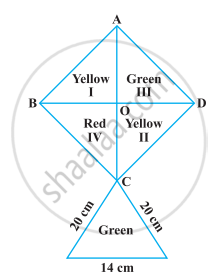Advertisements
Advertisements
प्रश्न
Find the area of the triangle formed by the points
(–10, –4), (–8, –1) and (–3, –5)
उत्तर
Let the vertices be A(–10, –4), B(–8, –1) and C(–3, –5)

Area of ∆ABC = `1/2[(x_1y_2 + x_2y_3 + x_3y_1) - (x_2y_1 + x_3y_2 + x_1y_3)]`
= `1/2[(50 + 3 + 32) - (12 + 40 + 10)]`
= `1/2[((-8 xx -4) + (-10 xx -5) + (-3 xx -1)),(-(-1 xx -10) + (-4 xx -3) + (-5 xx -8))]`
= `1/2[85 - 62]`
= `1/2[23]`
= 11.5
Area of ∆ACB = 11.5 sq.units
APPEARS IN
संबंधित प्रश्न
A traffic signal board, indicating ‘SCHOOL AHEAD’, is an equilateral triangle with side ‘a’. Find the area of the signal board, using Heron’s formula. If its perimeter is 180 cm, what will be the area of the signal board?
Find the area of a triangle whose sides are 3 cm, 4 cm and 5 cm respectively.
Using Heron’s formula, find the area of a triangle whose sides are 10 cm, 24 cm, 26 cm
An isosceles right triangle has area 8 cm2. The length of its hypotenuse is ______.
The area of the isosceles triangle is `5/4 sqrt(11)` cm2, if the perimeter is 11 cm and the base is 5 cm.
If the side of a rhombus is 10 cm and one diagonal is 16 cm, the area of the rhombus is 96 cm2.
The sides of a quadrilateral ABCD are 6 cm, 8 cm, 12 cm and 14 cm (taken in order) respectively, and the angle between the first two sides is a right angle. Find its area.
A rhombus shaped sheet with perimeter 40 cm and one diagonal 12 cm, is painted on both sides at the rate of Rs 5 per m2. Find the cost of painting.
How much paper of each shade is needed to make a kite given in the following figure, in which ABCD is a square with diagonal 44 cm.
The perimeter of a triangle is 50 cm. One side of a triangle is 4 cm longer than the smaller side and the third side is 6 cm less than twice the smaller side. Find the area of the triangle.
